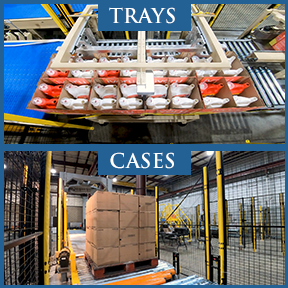
Trays or Cases: Choosing the Right Packaging for YOUR Product
In today's competitive market, the way a product is packaged can be just as important as the product itself. Packaging does not only protect your product during transit; it speaks volumes about your brand, influences consumer perception, and can significantly impact the decision to purchase. With this in mind, businesses are constantly faced with critical decisions on how best to package their products to optimize appeal, efficiency, and cost-effectiveness.
One such decision is choosing between packaging products in trays or in cases. Each option offers its own set of advantages and considerations, from cost implications and material usage to product size accommodation and presentation benefits. Trays, often seen as an elegant solution, provide easy access and visibility to the product, making them ideal for items requiring immediate display appeal. On the other hand, cases offer robust protection and are typically more suited for bulk storage and transport, presenting a practical choice for larger, heavier items or products needing enhanced security during shipment.
As we navigate through the intricacies of selecting the optimal packaging solution, several factors come into play. These include understanding the nuances of cost efficiency, evaluating the materials involved, considering the product's size and fragility, and, ultimately, how these choices align with consumer expectations and environmental sustainability goals.
This article aims to illuminate the differences between packaging products in trays and cases. By delving into the benefits and limitations of each, we will explore how businesses can make informed decisions that not only safeguard their products but also elevate their brand in the eyes of the consumer. Join us as we unpack the essentials of packaging choices, guiding you through a comprehensive comparison to ensure your product stands out for all the right reasons.
Packaging Products: The Tray vs. Case Debate
In the realm of packaging, the decision between using trays or cases is not merely a matter of preference but a strategic choice that can significantly impact a product's market performance. This choice influences everything from logistics and cost to the product's appeal on the shelf. Drawing from the insights provided in the introduction to end-of-line automation systems, it becomes evident that the method of packaging plays a critical role in the efficiency of warehousing and manufacturing processes. Let's explore the core differences between trays and cases, their advantages and disadvantages, and the various factors influencing the choice between them.
Core Differences Between Trays and Cases
Trays are typically open-topped packaging solutions ideal for products that benefit from visibility and easy access. They are often used for fruits, vegetables, baked goods, and other items where immediate product display is beneficial, especially in big box stores such as Sam's Club, Costco, and BJ's Wholesale Club. On the other hand, cases are enclosed boxes, generally made of cardboard, plastic, or wood, designed to protect and transport products. Cases are suitable for a wide range of products, from electronics to beverages, providing robust protection during shipping and handling.
IMPACT ON THE PRODUCT - Size, Shape, and Weight: Trays are best suited for lighter, uniformly shaped products that need to be displayed attractively. Cases, however, can accommodate a broader range of sizes, shapes, and weights, offering more versatility for bulkier or irregularly shaped items.
CHALLENGES AND CONSIDERATIONS
- Cost-Effectiveness: Cases tend to be more cost-effective for transporting large quantities of products due to their stackability and the protection they offer, reducing damage-related losses. Trays might require additional wrapping or overpack to achieve similar protection levels, potentially increasing costs.
- Sustainability: Sustainability concerns have pushed many companies to consider the environmental impact of their packaging choices. Trays, especially those made from biodegradable materials, often have a smaller environmental footprint than plastic cases. However, innovations in recyclable and reusable cases are narrowing this gap.
- Practicality: The practicality of using trays or cases depends on the specific needs of the product and the distribution channel. Trays offer convenience for products that are hand-selected by consumers, while cases provide better protection for products distributed through extensive logistics networks.
- Product Fragility and Target Market: For fragile products, the superior protection offered by cases may be necessary. However, the target market's preferences should also guide packaging decisions. For premium products, the presentation in a tray might enhance perceived value, appealing to consumers' desire for quality and aesthetics.
Expert Insight: Benefits and Limitations
TRAYS:
- Benefits: Enhance product visibility, encourage impulse buys, and may be perceived as more eco-friendly.
- Limitations: Offer less protection during transit, potentially leading to higher product damage rates.
CASES:
- Benefits: Provide robust protection, suitable for a wide range of products, and are highly stackable, optimizing storage and transport.
- Limitations: May obscure product visibility and incur higher material and recycling costs.
RECOMMENDATIONS FOR BEST PRACTICES:
When selecting the most appropriate packaging type for a product, consider the following best practices:
- Assess the Product's Needs: Evaluate the fragility, size, shape, and weight of the product.
- Consider the Distribution Channel: Determine the logistics required to get the product to market and choose packaging that supports this journey.
- Balance Cost with Sustainability: Aim for packaging solutions that minimize environmental impact without compromising cost-effectiveness.
- Understand Your Market: Tailor your packaging choice to the preferences and expectations of your target consumers.
In conclusion, whether to use trays or cases for packaging depends on a multifaceted evaluation of product characteristics, logistical requirements, cost considerations, sustainability goals, and consumer expectations. By carefully weighing these factors, businesses can make informed decisions that enhance product appeal, protect their goods, and align with their brand values and market objectives.
JOIN OUR MAILING LIST ---- Tray System Videos ---- Case System Videos ---- Request Quote
